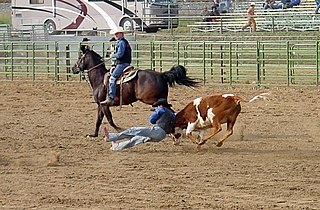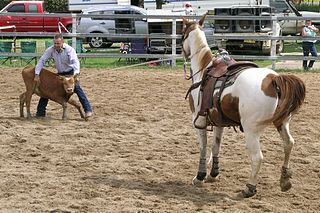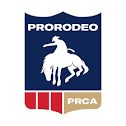
Rodeo is a competitive equestrian sport which arose out of the working practices of cattle herding in Spain and Mexico, expanding throughout the Americas and to other nations. It was originally based on the skills required of the working vaqueros and later, cowboys, in what today is the western United States, western Canada, and northern Mexico. Today, it is a sporting event that involves horses and other livestock, designed to test the skill and speed of the cowboys and cowgirls. Professional rodeos generally comprise the following events: tie-down roping, team roping, steer wrestling, saddle bronc riding, bareback bronc riding, bull riding, breakaway roping, and barrel racing. The events are divided into two basic categories: the timed events and rough stock events. Depending on sanctioning organization and region, other events such as goat tying and pole bending may also be a part of some rodeos. The "world's first public cowboy contest" was held on July 4, 1883, in Pecos, Texas, between cattle driver Trav Windham and roper Morg Livingston.

Bull riding is a rodeo sport that involves a rider getting on a bucking bull and attempting to stay mounted while the animal tries to buck off the rider.

Bronc riding, either bareback bronc or saddle bronc competition, is a rodeo event that involves a rodeo participant riding a bucking horse that attempts to throw or buck off the rider. Originally based on the necessary buck breaking skills of a working cowboy, the event is now a highly stylized competition that utilizes horses that often are specially bred for strength, agility, and bucking ability. It is recognized by most rodeo organizations such as the Professional Rodeo Cowboys Association (PRCA) and the International Professional Rodeo Association (IPRA).

Steer wrestling, also known as bulldogging, is a rodeo event in which a horse-mounted rider chases a steer, drops from the horse to the steer, then wrestles the steer to the ground by grabbing its horns and pulling it off-balance so that it falls to the ground. The event carries a high risk of injury to the cowboy. Some concerns from the animal-rights community express that the competition may include practices that constitute cruelty to animals, but the injury rate to animals is less than 0.05%. A later PRCA survey of 60,971 animal performances at 198 rodeo performances and 73 sections of "slack" indicated 27 animals were injured, again around 0.05%.

Team roping also known as heading and heeling is a rodeo event that features a steer and two mounted riders. The first roper is referred to as the "header", the person who ropes the front of the steer, usually around the horns, but it is also legal for the rope to go around the neck, or go around one horn and the nose resulting in what they call a "half head". Once the steer is caught by one of the three legal head catches, the header must dally and use his horse to turn the steer to the left.

Calf roping, also known as tie-down roping in the United States and Canada and rope and tie in Australia and New Zealand, is a rodeo event that features a calf and a rider mounted on a horse. The goal of this timed event is for the rider to catch the calf by throwing a loop of rope from a lariat around its neck, dismount from the horse, run to the calf, and restrain it by tying three legs together, in as short a time as possible. A variant on the sport, with fewer animal welfare controversies, is breakaway roping, where the calf is roped, but not tied.
Steer roping, also known as steer tripping or steer jerking, is a rodeo event that features a steer and one mounted cowboy.

The Women's Professional Rodeo Association (WPRA) is one of the largest rodeo sanctioning bodies in the world and is open exclusively to women eighteen years of age and older. Headquartered in Colorado Springs, Colorado, the Association currently has over 3,000 members from all over the contiguous United States, Canada, and Australia.
The National Finals Rodeo (NFR) is the premier championship rodeo of the Professional Rodeo Cowboys Association (PRCA). It showcases the talents of the PRCA's top 15 money winners in the season for each event.

The Professional Rodeo Cowboys Association (PRCA) is the largest rodeo organization in the world. It sanctions events in the United States, Canada, and Mexico, with members from said countries, as well as others. Its championship event is the National Finals Rodeo (NFR). The PRCA is headquartered in Colorado Springs, Colorado, United States.
History of rodeo tracks the lineage of modern Western rodeo.

A stock contractor is an individual or business that provides animals for rodeo competition. Stock contractors supply rough stock - bucking horses for saddle bronc and bareback bronc riding and bucking bulls for bull riding, plus steers for steer wrestling and team roping, plus calves for calf roping and breakaway roping events. The use of stock contractors who specialize in providing these animals has produced a more uniform range of bucking stock which is also quieter to handle.
The Heart of the North Rodeo is located in Spooner, Wisconsin, United States. The rodeo takes place the first full weekend in July every year since 1954, except 2020. It is sanctioned by the Professional Rodeo Cowboys Association (PRCA). Fans from all over come to watch the professional cowboys and cowgirls compete in the seven main events of rodeo, and even some up-and-coming little cowboys and cowgirls.
Fred Whitfield is an American former professional rodeo cowboy who specialized in tie-down roping. He won eight Professional Rodeo Cowboys Association (PRCA) world championships and three National Finals Rodeo (NFR) aggregate titles. Seven of those titles were tie-down roping world championships and one was the all-around world championship. He is one of a few African-American professional rodeo cowboys and by far the most successful. He was inducted into the ProRodeo Hall of Fame in 2004.
Phil Lyne is an American former professional rodeo cowboy who competed in the Rodeo Cowboys Association (RCA)/Professional Rodeo Cowboys Association (PRCA). He was the RCA Rookie of the Year in 1969. Two seasons later at the National Finals Rodeo (NFR), in 1971, he won the all-around cowboy world championship and the tie-down roping world championship. At the NFR in 1972, he repeated as the all-around world champion cowboy and added a second tie-down roping world championship. Lyne won his first and only steer roping world championship at the National Finals Steer Roping (NFSR) in 1990.

Dally ribbon roping, or simply ribbon roping, is a team rodeo event that features a steer and one mounted riders and one contestant on foot. It is a timed event. The roper starts in the box and the runner must start from a designated spot determined by the field judge. Some rules allow a runner to start anywhere in the arena.

Wanda Harper Bush was an American professional rodeo cowgirl. She competed in the Girl's Rodeo Association (GRA), now known as the Women's Professional Rodeo Association (WPRA), and won two barrel racing world championships, in 1952 and 1953. She was inducted into the National Cowgirl Museum and Hall of Fame in 1978 and the ProRodeo Hall of Fame in 2017. The August 2017 induction ceremony was ProRodeo's 38th annual event, and marked the first time in the event's history that the class of inductees included barrel racers from the Women's Professional Rodeo Association (WPRA).
Hailey Kinsel, is an American professional rodeo cowgirl who specializes in barrel racing and competes in the Women's Professional Rodeo Association (WPRA). She won the WPRA barrel-racing world championship in 2018, 2019, 2020, and 2022 at the National Finals Rodeo (NFR). She has also won the NFR Average title once in 2020. Kinsel and her horses have qualified for the NFR eight consecutive times in her years in professional rodeo from 2017 through 2024. She has been competing in rodeo since adolescence, winning awards through high school and college in both barrel racing and breakaway roping, as well as professional rodeo. Her horse, Sister, won the Barrel Racing Horse of the Year Award in 2018.
Gail Petska is an American former professional rodeo cowgirl who specialized in barrel racing. She was a two-time barrel racing world champion. In December 1972 and 1973, she won the championship at the National Finals Rodeo (NFR) at the State Fair Arena in Oklahoma City, Oklahoma.
The National Finals Breakaway Roping (NFBR), organized by the Women's Professional Rodeo Association (WPRA) and Professional Rodeo Cowboys Association (PRCA), is the premier championship breakaway roping event in the United States. It showcases the talents of the WPRA's top 15 money winners in the breakaway roping world standings at the end of the regular season as they compete for the world championship.










